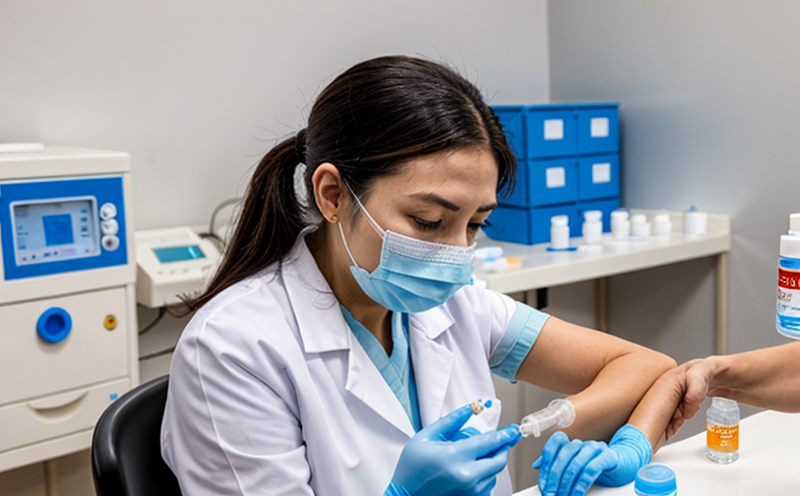EP Potency Testing of Polysaccharide Vaccines
The European Pharmacopoeia (EP) potency testing is a critical quality assurance measure ensuring that vaccines meet the required standards for efficacy and safety. This method evaluates the biological activity of polysaccharide-based vaccines, which are essential in preventing infectious diseases such as meningitis and pneumonia.
Polysaccharide vaccines consist of purified capsular polysaccharides from pathogenic microorganisms. These vaccines are typically conjugated to carrier proteins to enhance immunogenicity, making them highly effective against specific pathogens. The potency test assesses the number of biological units per dose, ensuring that each vaccine vial contains the correct amount of active ingredient necessary for a protective immune response.
The EP specifies detailed protocols and criteria for testing polysaccharide vaccines to ensure consistency and reliability across different batches and manufacturers. Compliance with these standards is crucial for maintaining public trust in pharmaceutical products and regulatory approval.
For quality managers and compliance officers, understanding the nuances of this test is vital. It helps them ensure that their laboratories are equipped with the necessary expertise and resources to perform accurate and reproducible potency tests. R&D engineers benefit from knowing the real-world application of these tests in developing new formulations and improving existing vaccines.
Proper preparation of samples for testing is essential; this includes ensuring that the polysaccharide is free from contaminants, maintaining the integrity of the conjugation process, and verifying the purity of the active ingredient. The use of advanced instrumentation such as high-performance liquid chromatography (HPLC) and bioassay techniques allows for precise measurement of biological activity.
The potency test results are reported according to strict guidelines outlined in the EP, providing a quantitative measure of vaccine efficacy. This information is critical for regulatory compliance and informing clinical trial designs. Compliance officers rely on these data points when assessing whether batches meet established thresholds, ensuring that only high-quality products reach the market.
Understanding the role of potency testing also aids procurement teams in selecting reliable suppliers who adhere to stringent quality standards. By leveraging this knowledge, they can make informed decisions about which manufacturers to partner with and ensure consistent supply chains for polysaccharide vaccines.
Why It Matters
The significance of EP potency testing cannot be overstated in the pharmaceutical industry. Ensuring that each dose of a polysaccharide vaccine contains the specified amount of active ingredient directly impacts patient safety and efficacy.
Non-compliance with these standards can lead to suboptimal protection against targeted pathogens, potentially resulting in increased morbidity or mortality rates among vaccinated populations. Regulatory bodies like the European Medicines Agency (EMA) closely monitor adherence to ensure public health is safeguarded.
From a business perspective, maintaining rigorous quality control measures reduces the risk of recalls and adverse events associated with ineffective vaccines. This not only protects brand reputation but also fosters long-term relationships with healthcare providers and consumers who trust in the reliability of pharmaceutical products.
The potency test results contribute to ongoing research efforts aimed at improving vaccine formulations. By identifying any discrepancies between expected and actual potency levels, researchers can pinpoint areas for improvement and optimize future iterations of these life-saving medications.
Scope and Methodology
| Step | Description |
|---|---|
| Sample Preparation | Purify the polysaccharide component and ensure it is free from contaminants. Perform conjugation with carrier proteins if applicable. |
| Bioassay Design | Determine the optimal conditions for assessing biological activity using standardized assays compliant with EP guidelines. |
| Standard Curve Calibration | Create calibration curves based on known concentrations of polysaccharide to correlate measured signals with actual amounts. |
| Data Analysis | Analyze the bioassay data to calculate the potency value for each batch, ensuring it meets EP requirements. |
Environmental and Sustainability Contributions
The process of EP potency testing contributes positively to environmental sustainability by fostering responsible manufacturing practices. Ensuring that vaccines meet strict quality standards minimizes wastage due to ineffective or substandard products reaching the market.
By adhering to stringent testing protocols, pharmaceutical companies can contribute to reducing healthcare costs associated with preventable diseases. This, in turn, leads to more efficient resource utilization and reduced environmental impact from unnecessary treatments and hospitalizations.





